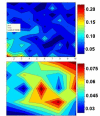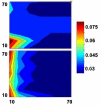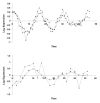Accelerated search for biomolecular network models to interpret high-throughput experimental data
- PMID: 17640351
- PMCID: PMC1940030
- DOI: 10.1186/1471-2105-8-258
Accelerated search for biomolecular network models to interpret high-throughput experimental data
Abstract
Background: The functions of human cells are carried out by biomolecular networks, which include proteins, genes, and regulatory sites within DNA that encode and control protein expression. Models of biomolecular network structure and dynamics can be inferred from high-throughput measurements of gene and protein expression. We build on our previously developed fuzzy logic method for bridging quantitative and qualitative biological data to address the challenges of noisy, low resolution high-throughput measurements, i.e., from gene expression microarrays. We employ an evolutionary search algorithm to accelerate the search for hypothetical fuzzy biomolecular network models consistent with a biological data set. We also develop a method to estimate the probability of a potential network model fitting a set of data by chance. The resulting metric provides an estimate of both model quality and dataset quality, identifying data that are too noisy to identify meaningful correlations between the measured variables.
Results: Optimal parameters for the evolutionary search were identified based on artificial data, and the algorithm showed scalable and consistent performance for as many as 150 variables. The method was tested on previously published human cell cycle gene expression microarray data sets. The evolutionary search method was found to converge to the results of exhaustive search. The randomized evolutionary search was able to converge on a set of similar best-fitting network models on different training data sets after 30 generations running 30 models per generation. Consistent results were found regardless of which of the published data sets were used to train or verify the quantitative predictions of the best-fitting models for cell cycle gene dynamics.
Conclusion: Our results demonstrate the capability of scalable evolutionary search for fuzzy network models to address the problem of inferring models based on complex, noisy biomolecular data sets. This approach yields multiple alternative models that are consistent with the data, yielding a constrained set of hypotheses that can be used to optimally design subsequent experiments.
Figures







Similar articles
-
Linear fuzzy gene network models obtained from microarray data by exhaustive search.BMC Bioinformatics. 2004 Aug 10;5:108. doi: 10.1186/1471-2105-5-108. BMC Bioinformatics. 2004. PMID: 15304201 Free PMC article.
-
Building interpretable fuzzy models for high dimensional data analysis in cancer diagnosis.BMC Genomics. 2011;12 Suppl 2(Suppl 2):S5. doi: 10.1186/1471-2164-12-S2-S5. Epub 2011 Jul 27. BMC Genomics. 2011. PMID: 21989191 Free PMC article.
-
DFP: a Bioconductor package for fuzzy profile identification and gene reduction of microarray data.BMC Bioinformatics. 2009 Jan 29;10:37. doi: 10.1186/1471-2105-10-37. BMC Bioinformatics. 2009. PMID: 19178723 Free PMC article.
-
Fuzzy logic based approaches for gene regulatory network inference.Artif Intell Med. 2019 Jun;97:189-203. doi: 10.1016/j.artmed.2018.12.004. Epub 2018 Dec 17. Artif Intell Med. 2019. PMID: 30573378 Review.
-
Techniques for clustering gene expression data.Comput Biol Med. 2008 Mar;38(3):283-93. doi: 10.1016/j.compbiomed.2007.11.001. Epub 2007 Dec 3. Comput Biol Med. 2008. PMID: 18061589 Review.
Cited by
-
Borges dilemma, fundamental laws, and systems biology.Bioinform Biol Insights. 2008 Apr 10;2:201-2. Bioinform Biol Insights. 2008. PMID: 19812776 Free PMC article. No abstract available.
-
An integrated framework to model cellular phenotype as a component of biochemical networks.Adv Bioinformatics. 2011;2011:608295. doi: 10.1155/2011/608295. Epub 2011 Nov 29. Adv Bioinformatics. 2011. PMID: 22190923 Free PMC article.
-
Estimation of Parameters Subject to Order Restrictions on a Circle With Application to Estimation of Phase Angles of Cell Cycle Genes.J Am Stat Assoc. 2009 Mar 1;104(485):338-347. doi: 10.1198/jasa.2009.0120. J Am Stat Assoc. 2009. PMID: 19750145 Free PMC article.
-
Identifying functional gene regulatory network phenotypes underlying single cell transcriptional variability.Prog Biophys Mol Biol. 2015 Jan;117(1):87-98. doi: 10.1016/j.pbiomolbio.2014.11.004. Epub 2014 Nov 27. Prog Biophys Mol Biol. 2015. PMID: 25433230 Free PMC article.
References
-
- Liang S, Fuhrman S, Somogyi R. REVEAL, a general reverse engineering algorithm for inference of genetic network archictectures. Pacific Symposium on Biocomputing. 2000;3:18–29. - PubMed
MeSH terms
LinkOut - more resources
Full Text Sources

